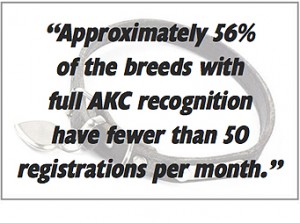Promoting Rare Breeds
152 – October, 2017
By William Given
 While my wife and I were waiting for the Group judging to begin at a recent all-breed show, my ringside neighbor introduced himself as an owner and breeder of one of the comparatively rare breeds (average monthly registration under 20). After our introductions and learning that I write for The Canine Chronicle, he asked me for some suggestions that he, his wife and a few friends could utilize to increase
While my wife and I were waiting for the Group judging to begin at a recent all-breed show, my ringside neighbor introduced himself as an owner and breeder of one of the comparatively rare breeds (average monthly registration under 20). After our introductions and learning that I write for The Canine Chronicle, he asked me for some suggestions that he, his wife and a few friends could utilize to increase
the popularity of their breed.
I do have to say, that for a good many years, I have given much more thought to the problems faced by breeders of those breeds having so great a popularity that they become the targets of “puppy mill” operators. And, this problem certainly continues to bear watching. After a breed reaches the number of individual registrations to place it in the “top ten,” the problem becomes more one of maintaining popularity, but also encouraging breeding of dogs with the proper type and temperament. No breed reaches registration counts over 20,000 per year without most of the dog loving public knowing the name of the breed by sight, and having more than a gen- eral idea of the qualities the breed has to offer and the type of living situation to which it is most satisfactorily adapted.
Interestingly, approximately 56% of the breeds with full AKC recognition have fewer than 50 registrations per month. When you wander out of the top twenty most popular breeds, names begin to appear which are less well-known. The average person might not be quick to identify the Cane Corso (holding the number 35 spot) or a Coton De Tulear (coming in at number 85) when seen being walked down Main Street. City dwellers could not reasonably be expected to know the American or English Fox- hound nor their seemingly smaller cousin the Harrier, and the same goes for country folk. They may not be readily able to distinguish the Shih Tzu from a Lhasa Apso from a Havanese. Many owners often have to take a second look to make sure they know what breed they are looking at. And, that does begin to address the many other breeds recognized by the American Kennel Club.
Click here to read the complete article152 – October, 2017
Short URL: http://caninechronicle.com/?p=133734
Comments are closed











